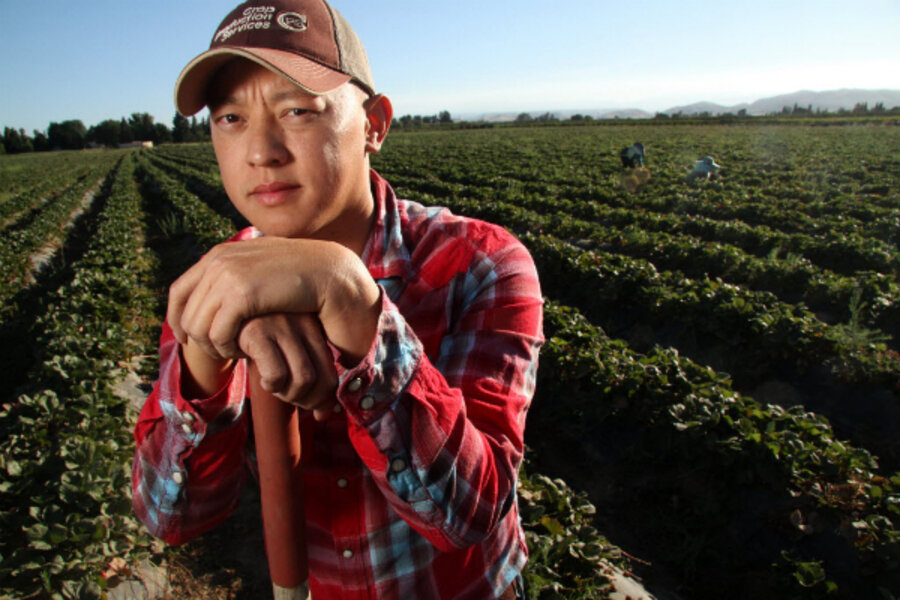Immigration and assimilation: After dislocation, a Hmong refugee finds a fit
Loading...
| Clovis, Calif.
Dressed in a red plaid shirt, jeans, and dusty boots, his brow beaded with sweat, Kouei Siong looks every bit the American farmer. Sitting in the shade of his family's roadside produce stand here in the Central Valley of California, he can see his family's 20-plus acres of berries, tomatoes, lettuce, zucchini, chilies, and eggplant fanning out in orderly rows beyond the parking lot.
Farming is his future, a way of fitting in here in America, Mr. Siong now believes – even if he spent much of his life trying to avoid it. He remembers all too well the teasing that came with being the teenage son of Hmong immigrant farmers in the Central Valley in the late 1990s.
"The white kids would always mock the Asian kids," he says, shaking his head. "You know, 'You guys are a bunch of farmers, a bunch of dumb kids, a bunch of immigrants.' That was tough."
After studying business administration at Fresno City College and working as a corrections officer for the Fresno County Sheriff's Office, Siong, now 31, has come back to the family farm, and he's not planning on leaving anytime soon.
"It isn't like it was when I was younger," he says, explaining that working the land and being his own boss became more important as he grew older. "Hey, I'm not ashamed of it: I like being a farmer."
It's a resolution that, after a lifetime's worth of dislocation and change, finally makes him feel settled. Siong's parents, Heu Long and Bao Moua, were born in Laos. Siong and three of his siblings, however, were born in France, a 13-year way station for his family after they left Southeast Asia in 1977. Like most Hmong (a Southeast Asian ethnic people), the Siongs are refugees: During the Vietnam War, men like Heu Long were recruited to fight as allies of the United States against the Vietcong in Laos; when the US pulled its troops, deadly persecution scattered the Hmong halfway around the globe.
California's fertile Central Valley became a hub of the diaspora – with 32,000 of them living in this Fresno area. About 900 Hmong work one- or two-acre farm plots near here, growing specialty Asian crops like yardlong beans and lemon grass, says Michael Yang, the Hmong agricultural assistant for the University of California Cooperative Extension in Fresno County. And, like the Siongs, 85 to 90 percent rent their land. The language barrier is still a challenge for first-generation immigrants, Mr. Yang says, as are government regulations.
"Back in their homeland, they use aunts and uncles, close relatives, to trade work," says Yang, himself a Hmong who lost his father in the war and spent several years toting an M-1 carbine through Laotian jungles en route to a Thai refugee camp. "But here, if you have relatives come to your field to do a little bit of work, when the Labor Department or OSHA [Occupational Safety and Health Administration] goes out there, you get a citation."
Heu Long Siong is tired of that sort of intervention, and he's slightly skeptical of his son's plans to expand the family business.
Kouei, though, is optimistic about what the farm could be – and his ability to tap that potential. He's already got the equipment and the know-how, and he's banking on years of experience with Americans – in school, on the job – to push him the extra mile. He came to the States when he was 8 years old, and though the Central Valley didn't resemble the "Miami Vice"-like America he and his siblings expected before leaving France, he's felt increasingly comfortable as the years pass, his French accent fading the more he grew into his new home.
He dabbles as a DJ, spinning trance music to "get away from the real world." He teases his white friends about how bland their dinners are compared with his Hmong favorites, like boiled pork with mustard greens. And he celebrates recent signs of acceptance, like the opening last year of Fresno's Vang Pao Elementary School, named after a Hmong guerrilla general.
"We're not just Hmong people – we're actually Hmong-American," Siong says. "We can fit in and talk to everyone now."
Although his parents prefer the simplicity of the fruit stand, Siong envisions giving it up to sell directly to distributors. He wants to start with 10 acres of his own and build slowly, growing jujubes, crab-apple-like fruits popular with Asian and Middle Eastern customers.
As the older generation of Hmong farmers nears retirement, Siong figures the time is right to, as he puts it in the most American of ways, "Go big or go home."







